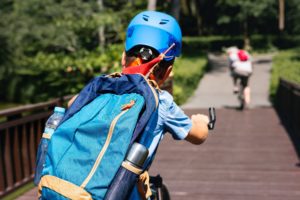

Here’s another blog from Sarah McCabe. This time she focuses on PE and how it needs to be taught, especially in primary school.

Unlike some of the main core subjects, Physical Education has a highly unique nature in respect of the quality of available teaching space. The vast majority of PE tuition is primarily based around the external environment, in contrast to the norm of sitting within a classroom. Within the classroom setting, the teacher is able to differentiate the educational levels of each pupil; and adapt their teaching methods accordingly. Physical education offers the opportunity for pupils of any ability to all work collectively within a group setting, to develop their fundamental motor skills during the process. This process is vital within young children, as they are unknowingly becoming physically literate; which equally has a significant impact upon their educational success.
The existence of concise and clear expectations and targets for children to achieve, not only reiterates the importance of being active; but also reinforces the significance of a child’s need to acquire a healthy lifestyle. To further corroborate this, PE within the curriculum is compulsory for all children for at least two hours a week. This statutory provision endorses that physical education is not a subject to be overlooked and neglected by professionals within the classroom environment. A lesser focus on PE would inevitably result in more prolonged periods of concentrating on delivering the core subjects. This position was reiterated by Education Secretary, Nicky Morgan, in 2014. She stated that the Government “want to create a world-class education system that gives children all the skills they need to succeed in modern Britain”. Morgan highlights how Literacy and Numeracy are undoubtedly a key part of the education system. However, emphasized that confidence, discipline, and determination are equally important for a child’s success. Evidently, it seems that a higher proportion of professionals are now becoming more aware and receptive to the development of physical education within the curriculum.
Furthermore, a substantial component of physical education being recognized as a unique subject, is the guidance and understanding of undertaking a healthy lifestyle. This includes the drive for individuals to develop a positive mind and a personal physical and mental well-being. The World Health Organization defines a healthy lifestyle as; “A way of living that lowers the risk of being seriously ill or dying early…it is also about physical, mental and social wellbeing”. The common adage within children is that their physical education lessons are a time for pleasure and amusement is very well known (and in most cases well received) among the students. Nonetheless, students are unaware of the considerable positive “mental and social wellbeing” benefits from active participation in PE. Engaging children in educational-based physical exercise during a PE lesson, can clearly provide a distraction method for children. They become automatic participants in generating the raw material of the curriculum work, without being under the impression they are within a generic subject lesson.
Within the 21st Century, obesity within Britain is becoming a frequent issue for the NHS, especially among children. According to data from the National Child Measurement Programme, (NCMP), 9% of reception age children (age 4-5) are obese. A further 13% have been diagnosed as overweight. For some children, PE lessons are their only opportunity to take part in frequent exercise. Without this opportunity to become physically active, children tend to spend much of their day sat in front of a TV screen instead of adventuring outside. The extensive couch-based technological developments that exist within our culture is clearly having a substantial impact on childhood obesity. In addition to the overwhelming increase of childhood obesity, the Physical Inactivity Cycle examines the assumption that if a child does not have any experience of physical activity in their early childhood years, then this will have a negative impact on their transition to adulthood. The study endorses the position that if children remains physically idle; then their educational level will be severely low compared to that of a child who is physically active. The resultant outcome being that child becomes twice as likely to become obese in adulthood.
From my experience within schools, the growing issue with obesity within primary school pupils is slowly being introduced and discussed within the classroom. The aim being to improve the child’s knowledge on their own individual health literacy. Teachers are now dedicating time within the classroom to discuss matters such as healthy eating and the positive benefits of living an active life. Furthermore, whilst observing a teacher on placement, their pedagogy of Whole Part Whole was something I found highly effective as a method of teaching PE. This emerging pedagogy involves the teacher providing guidance to the students to ensure they learn the correct skill/technique effectively. To do this, the teacher delivers practical demonstrations on new skills. This pupil will then be encouraged to replicate these skills and the opportunity and encouragement given to the learner to feedback on the skill they found tough, and what they can do to improve. Allowing children to challenge themselves without the fear of being incorrect is a unique attribute afforded to PE in comparison to other subjects. The physical education offers the opportunity for students to explore differing methods of completing a new skill/sport; and for them to be able to choose the approach which is best suited to them.
I have previously implied that there are crucial differences between the subject of PE and that of English, Science and Mathematics; and my submission that Physical Education is absolutely essential to a child’s development. Creativity plays an important role within most curriculum subjects, However, creativity within PE can be viewed as being absolutely vital. Physical education allows children to take control of their own learning and select their own independent learning style which will best suit their needs. “Creativity is somewhat open minded, in that it involves play in many contexts, including learning through play or playing with ideas”. The concept of open mindedness allows the opportunity for students to be profoundly engaged and inspired to learn in considerable depth. Furthermore, the theory of constructivism considers that children create meaning by connecting their ideas with their individual experiences, both inside the classroom and out. From an early development stage (EYFS), if children are encouraged to be analytical about themselves in the way they learn, whether that may be as a social, creative or an active learner, the professional involved may see a creative and cultural development on the individual’s physical literacy. This personal way of learning is imperative for the construction of a child’s imagination and generating advanced and original ideas into their PE lessons. As indicated previously, PE offers children of any educational ability to be involved and work assiduously as a team, and the idea of creativity is no different.
The Primary PE and Sport Premium was introduced in 2013 with the hypothesis of creating a fundamental difference within physical education lessons. Sport Premium and Pupil Premium are the only financial income schools receive from the Government; reinforcing the concept that PE is on the increase. The Ofsted inspections of primary schools, appears to support this approach. They announced that schools could be overhauled to place a lesser focus on English and Math’s due to fears that pupils are missing out on a “broad and balanced curriculum” . The direct acknowledgement of physical education being as meaningful to a child’s educational advancement is something, which in my placement exchange, is particularly peculiar. From my personal practice, Schools do tend to apply the vast proportion of resources in studying the core subjects; and a less enthusiastic approach to physical education. Similarly, this finding is comparable to that of physical education within other countries in the world. For example, Africa tend to fixate on subjects which children are tested on, and ignore subjects, or do not spend a great deal of time, which do not fit this agenda. In Africa, “PE is not part of the school curriculum and sometimes appears on the timetable, it is either not taught regularly or not taught at all,”. If School’s are not routinely encouraged to strengthen the need for children to be involved within PE lessons, then teachers may become reluctant to take control. Paradoxically, the Sport Northern Ireland Primary Schools Survey highlighted a higher proportion of rural schools achieved a two-hour target of physical education curriculum time allocation. This confirms how some countries in the world still believe in the applicability of sport within the everyday lives of children within primary schools. Moreover, the effectiveness of this premium has been a main feature of many Government statistics as; “96% of schools reported improvements in pupils’ physical fitness, 93% saw improvements in behavior, and 96% thought the funding had contributed to a healthier lifestyle for their pupils.”